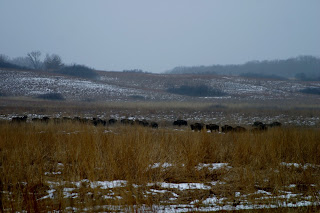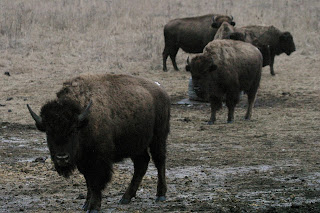Bison were extirpated from Illinois in the 1830s. The population once numbered more than 50 million, spanning across North America from the Gulf of Mexico all the way up to Alaska. At 6 ft. tall and 2000 lbs, Bison are the largest land animal in North America, a remnant of the mega fauna that once roamed the continent thousands of years ago. However, by the end of the 19th century, their numbers dropped to only 1000 individuals (less than 100 of them free roaming), isolated in a few places in western states. Through vigorous conservation efforts Bison have been brought back from the brink of extinction yet for many of the states where they once roamed, they remain absent with the exception of some captive bred populations for meat. This changed in Illinois in October 2014 with the reintroduction of a herd of wild Bison at Nachusa Grasslands, a Nature Conservancy owned property in Franklin Grove, IL, 90 miles west of Chicago.
Originating on 400 acres of land purchased in 1986, Nachusa Grasslands is a unique site that today protects approximately 3500 acres of restored tallgrass prairie that once covered much of the midwest. Tallgrass prairie, like Bison, suffered greatly at the expense of land development for agriculture as European settlers arrived in North America. In Illinois more than 99% of the original prairie was lost and converted to farmland. The Nature Conservancy, an environmental nonprofit, owns and operates the land and has worked to restore the site with more than 700 species of native prairie plants and more than 200 species of birds, mammals, reptiles, and amphibians. Thanks to the help of volunteers and staff, more than 100,000 hours of work have resulted in a beautiful nature preserve.
The idea for Bison reintroduction originated due to the many benefits that they provide to the prairie ecosystem. Bison grazing was a major force to promote growth and rejuvenation of the prairie, the impact of which was exceeded in magnitude only by wildfires and drought. Under their tremendous weight, depressions are carved out in the soil to create pools of water that provide breeding habitat for amphibians. Their hooves aerate and loosen topsoil while their coats transport and disperse seeds that stick to their dense fur. Bison also help remove trees, which allows light to reach prairie grasses and shrubs that require full sun.
Beginning with 20 individuals transported from Wind Cave National Park in South Dakota as well as other Nature Conservancy Sites (this isn't their first time reintroducing bison), the herd arrived in October 2014 and currently roam more than 1500 acres. The population is unique in that it is descended from pure strains of Bison. Many of the captive bison that we see today in the meat industry are actually descended from "beefalo" hybrids between Bison and cattle.The herd at Nachusa has grown to around 50 individuals thanks to the birth of several calves. April 6th, 2015 marked the first wild Bison born east of the Mississippi River in nearly 200 years.
While no hiking is permitted within the Bison units (which are fenced off to keep the bison in and people out), visitors are encouraged to stop by and view the herd from outside the enclosure. The bison roam freely all year without human intervention in feeding, breeding, or survival, with the exception of one day of veterinary examination. I spent Friday afternoon hiking near the Bison Unit observing the herd. They were pretty close to the outer boundaries of the unit so I was able to get some decent pictures with a zoom lens. While the rolling hills of the preserve obstructed my view of farmhouses and other signs of civilization I watched the bison wander across the prairie and I began to imagine what Illinois looked like hundreds of years ago. In the year since the reintroduction the project has appeared pretty successful and a second herd has been established in Illinois at Midewin National Tallgrass Prairie near Joliet. It's exciting to see what will come of this incredible conservation project and I'm really happy to have Bison back in Illinois.
For more info on Nachusa Grasslands, the Bison, and volunteering check out:
















No comments:
Post a Comment